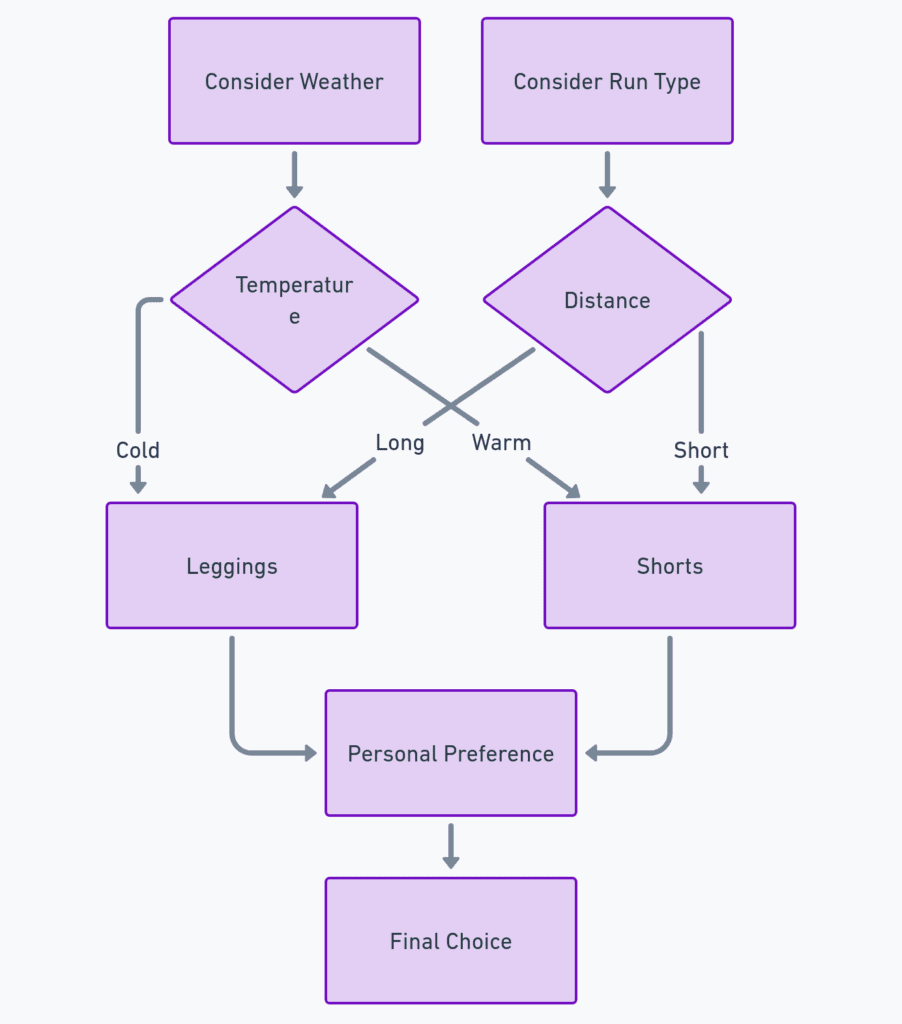When it comes to enhancing your running experience, the choice between leggings and running shorts is a pivotal decision that affects not just your comfort but also your performance and recovery. This guide is designed to merge comprehensive insights on the benefits and drawbacks of leggings versus tights for running, aiming to assist you in making an informed decision that aligns with your personal running needs and preferences.
Pros of Running Leggings
Enhanced Muscle Support
Leggings provide compression, improving blood flow and reducing muscle fatigue, crucial for long runs or recovery periods.
Weather Versatility
Offering protection in cold weather and some materials even providing UV protection for sunny days, leggings are adaptable to various conditions.
Reduced Chafing
Their snug fit minimizes the risk of skin irritation and chafing, enhancing your running comfort.
Style Variety
Available in numerous designs and materials, leggings can satisfy personal style preferences and accommodate different weather scenarios.
Cons of Running Leggings
Heat Retention
In warmer climates, leggings may trap excessive heat, causing discomfort or overheating.
Potential Mobility Restrictions
Some runners might find the compression of leggings restrictive, impacting stride and flexibility.
Pros of Running Shorts
Enhanced Breathability
Shorts promote better air circulation, offering a cooling effect in warm weather.
Freedom of Movement
Their looser fit ensures greater mobility, beneficial for speed training or shorter runs.
Lightweight Feel
Often lighter than leggings, shorts can contribute to a sensation of agility and speed.
Cons of Running Shorts
Limited Muscle Support
Lacking compression, shorts might not provide the same level of muscle support as leggings, potentially leading to quicker fatigue.
Exposure to Elements
Offering minimal protection against cold or harsh weather conditions.
Increased Chafing Risk
The looser fit of shorts could lead to chafing on longer runs.
Leggings vs. Shorts: Performance and Style Compared
Performance Impact
The choice between leggings and shorts may influence your speed and endurance, depending on individual preferences and environmental conditions. Leggings could be more beneficial in cooler climates by keeping muscles warm and supported, whereas shorts might be the go-to in warmer conditions for their cooling effect.
Style and Personal Comfort
While fashion trends continuously evolve, the ultimate choice between leggings and running shorts boils down to what makes you feel most comfortable and confident. Some runners gravitate towards the sleek, form-fitting appeal of leggings, while others prefer the relaxed and breezy feel of shorts.
Making the Ideal Choice: What to Consider
- Personal Needs and Body Type: Consider your unique body type and what you personally require from your running attire.
- Weather and Environmental Conditions: Factor in the typical weather conditions and the environment you’ll be running in.
- Personal Comfort: Above all, your comfort is paramount. Wearing what makes you feel good can significantly boost your running performance and enjoyment.
Recommendations:
- For Long-Distance Runners: Leggings may offer the support and warmth needed for those long miles.
- For Sprinters and Casual Joggers: Shorts could be the preferable choice for their lightweight and airy design.
Flowchart: Navigating Your Running Gear Decision
The decision-making process can be visualized through a simple flowchart:

This diagram underscores the importance of considering weather conditions, the nature of your run, and personal comfort in making your choice between leggings and running shorts.
Tailoring Your Gear to Your Goals
The debate between leggings and running shorts doesn’t have a one-size-fits-all answer. It’s about finding what best supports your running goals, ensures maximum comfort, and ultimately enhances your performance. Whether you opt for the snug, supportive embrace of leggings or the airy, liberating feel of shorts, the right choice is the one that aligns with your personal needs and running conditions. Experimentation is key; don’t hesitate to try both options across different scenarios to discover what truly works best for you. Remember, the right running gear is a crucial ally in your journey towards achieving your running objectives.
Frequently Asked Questions (FAQs)
1. Can wearing leggings or running shorts improve my running performance?
While the attire itself may not directly enhance performance, the right choice can affect your comfort, which in turn influences your endurance and speed. Leggings may provide compression that supports muscle efficiency, and shorts offer cooling benefits that might help you maintain pace in warm conditions.
2. How do I choose between leggings and shorts when running in variable weather conditions?
Consider layering your running attire. In transitional weather, you might start with leggings and wear shorts on top, removing a layer as necessary. Always pay attention to the weather forecast and prioritize clothing that offers adaptability, such as moisture-wicking and breathable fabrics.
3. Are there specific types of leggings and shorts designed for different types of running (e.g., trail running vs. road running)?
Yes, specific designs cater to the demands of different running environments. Trail running gear often features more durable materials to withstand rough terrain, along with pockets for essentials. Road running attire might focus on lightweight and aerodynamic designs for speed and efficiency.
4. How important is the material of leggings and running shorts?
Material is crucial for managing sweat, ensuring comfort, and preventing chafing. Look for synthetic fabrics like polyester and nylon that are breathable and moisture-wicking. Natural materials like cotton can absorb sweat, becoming heavy and potentially leading to discomfort or irritation.
5. Can the wrong running attire cause injuries?
While improper attire might not directly cause injuries, it can lead to conditions that increase the risk. For instance, ill-fitting shoes are a known cause of injuries, but so can be poorly chosen running clothes that lead to chafing, overheating, or insufficient support, affecting your gait or running form.
6. Is there a difference in the washing care for leggings and running shorts?
Generally, both should be washed in cold water to prevent shrinking and preserve the integrity of the fabric. Avoid fabric softeners and bleach, as they can break down the material’s moisture-wicking properties. Check the care label for specific instructions to ensure longevity.
7. How often should I replace my running leggings or shorts?
It depends on the frequency of use and the quality of the garment. Signs of wear such as thinning fabric, loss of elasticity, or fading indicate it’s time for a replacement. As a general guideline, evaluating your running wardrobe annually is a good practice to ensure your gear is in optimal condition.

